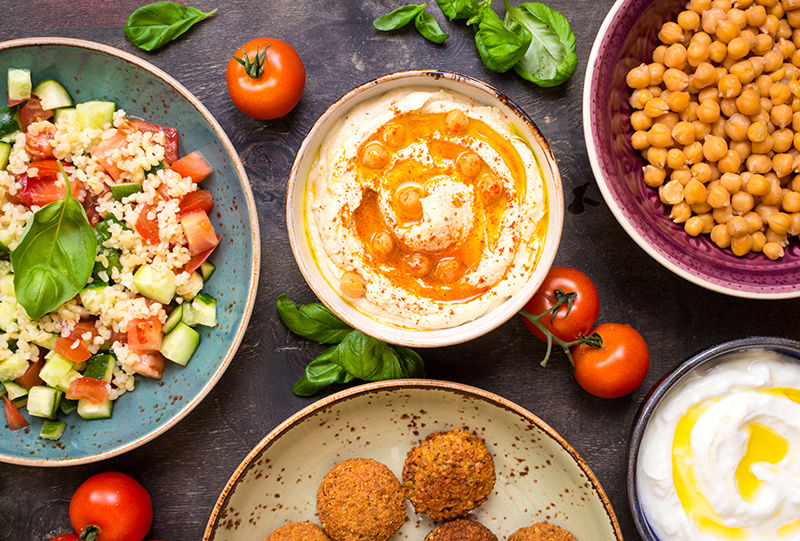One of the greatest discoveries of my early years in L.A. was the Jons Market on Hobart and Santa Monica Boulevards in East Hollywood.
Jons was my introduction to the culinary wonders of the Middle East. Cartons of sour cherry and black currant juice. Kefir, smoked herring, eight kinds of feta. Sugared almonds, sheets of apricot paste, rounds of dried figs. Rustic blocks of deep brown-green olive oil soap. And $6.99-a-pound loose tea in a box of cheap pink cardboard with Arabic lettering, strong pots of which saw me through several winters and the writing of at least two books.
Later I would discover the mom-and-pop markets all up and down Santa Monica Boulevard in that part of town: holes-in-the-wall with fresh lamejun, dirt-cheap produce, haughty cashiers and deliriously crabby customers.
But who cared? Attending 5:30 p.m. Mass at Immaculate Heart of Mary, then getting my shins barked in the couscous aisle by an impatient, cart-wheeling fellow shopper (often a guy with a three-day beard and a pack of Ararats sticking out of his shirt pocket) was part of the fun.
These folks were the original small batch enthusiasts. One day there might be a sawed-off cardboard box of shriveled brown nuggets with desiccated leaves attached: fresh hazelnuts, it turned out, that had clearly been picked on some rocky outcropping in Crete.
Another day I might come across a tiny pile of delicate champagne grapes, a bucket of raw pistachios, or a few branches of fresh yellow dates, still clinging to the vine.
At one of my favorite spots, a lady in a housedress cooked up delicious concoctions in an electric frying pan behind the meat counter: roasted peppers and onions, paper-thin slices of eggplant in a sauce of yogurt, ground walnuts and tahini.
Then a friend turned me on to Super King: which is the mom-and-pop places times a thousand. I first went to the one on San Fernando in the Glendale area (there are six other Southern Cal locations).
Just parking your car and nabbing a cart at Super King is an extreme sport.
Inside, the produce section takes up the whole right-hand side of the store. In addition to the basics, there are seasonal treats — fresh fava beans in spring persimmons in fall — and bins of items you’d be hard-pressed to find anywhere else: purslane, fenugreek, dandelion greens, currants, chestnuts, quince.
Strolling the aisles, you’ll find a crazy array of every grade and size of bulgur, lentils, rice. A deli with fresh pita, lavash, and sangak, an Iranian whole wheat leavened flatbread that comes in sheets big enough to unfurl and sail a boat with. There are tinned anchovies, pomegranate molasses and, in the baking section, tiny containers of mastic, the resin from the Pistacia Lentiscus tree, said to taste like a cross between licorice and pine and known to Old Testament readers from the story of Susanna and the dastardly three old men in Daniel 13.
Alain de Botton is the British-based author whose theme is the relevance of philosophy to everyday day life. He and fellow philosopher John Armstrong co-wrote “Art as Therapy,” an intriguing book of text and photos.
In a section called “The Importance of the South,” the authors report that mid-century British food writer Elizabeth David spent the war years in the south of France, Greece and Egypt, then returned to “a draughty flat in Chelsea.” There, she experienced an “agonized craving for the sun” that included the climate, people, lifestyle, architecture — and above all, the food — of the Mediterranean. She wrote “a succession of beguiling and influential recipe books,” and was hailed upon her death in 1992 by writer Auberon Waugh as the person who had brought about the greatest improvement in English life in the 20th century.
David was hardly the first, we learn, to be captivated by the food of the Mediterranean. “[I]n the 1780s Goethe was so moved when he went to Italy for the first time that he regretted everything that had occurred in his life up to that point. … He ate a lot of fruit [he was especially fond of figs and peaches, which were hard to get at home in Weimar].”
On a visit to the Bay of Naples in 1876, Nietzsche discovered lemons, olives, mozzarella and avocados. “The trip changed the direction of his thought: he moved away from his previous neo-Christian pessimism and embraced a more life-affirming Hellenism.” Cyril Connolly, the 20th century English literary critic and essayist, drove the coast of France with a girlfriend and proposed starting a new religion “whose most sacred items would be the olive and the lemon — in other words, the two totemic culinary items of the Mediterranean.”
He needn’t have proposed a new religion. With a feast at its center, no religion could accord food — in particular, the shared meal — a higher place of honor than Catholicism.
We have a Savior from Palestine — the king of all kings — who was raised on oil from olives, wine from grapes, bread from sun-warmed wheat. Then he offered himself up to be broken on the altar and left us his Body and Blood as a perpetual feast.
Wherever we live, our very menu is Southern-based.
Heather King is a blogger, speaker and the author of several books.

